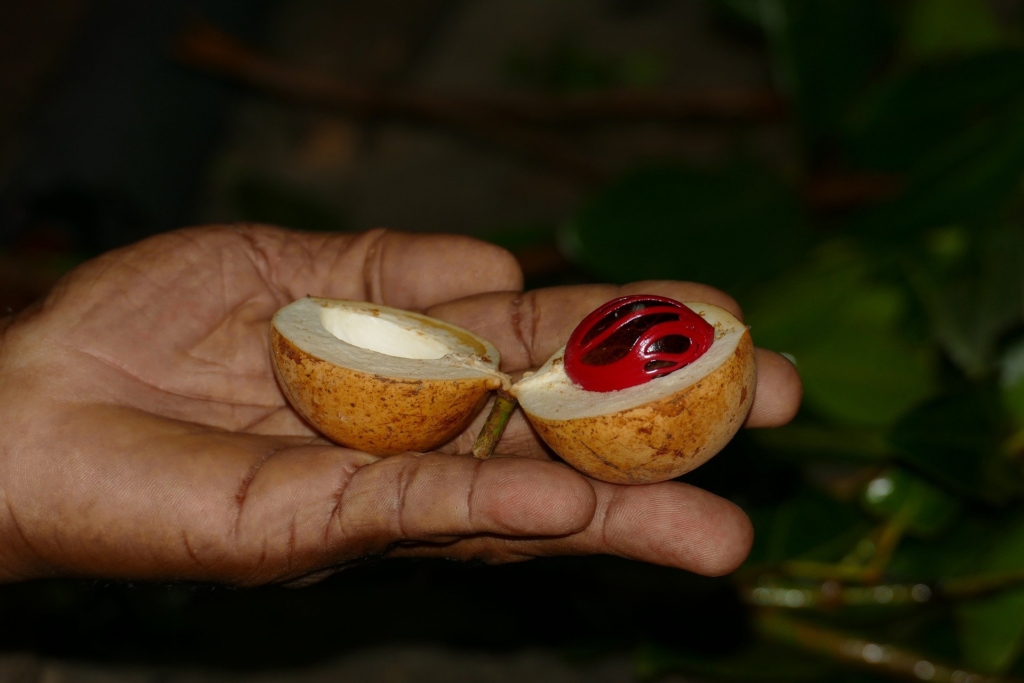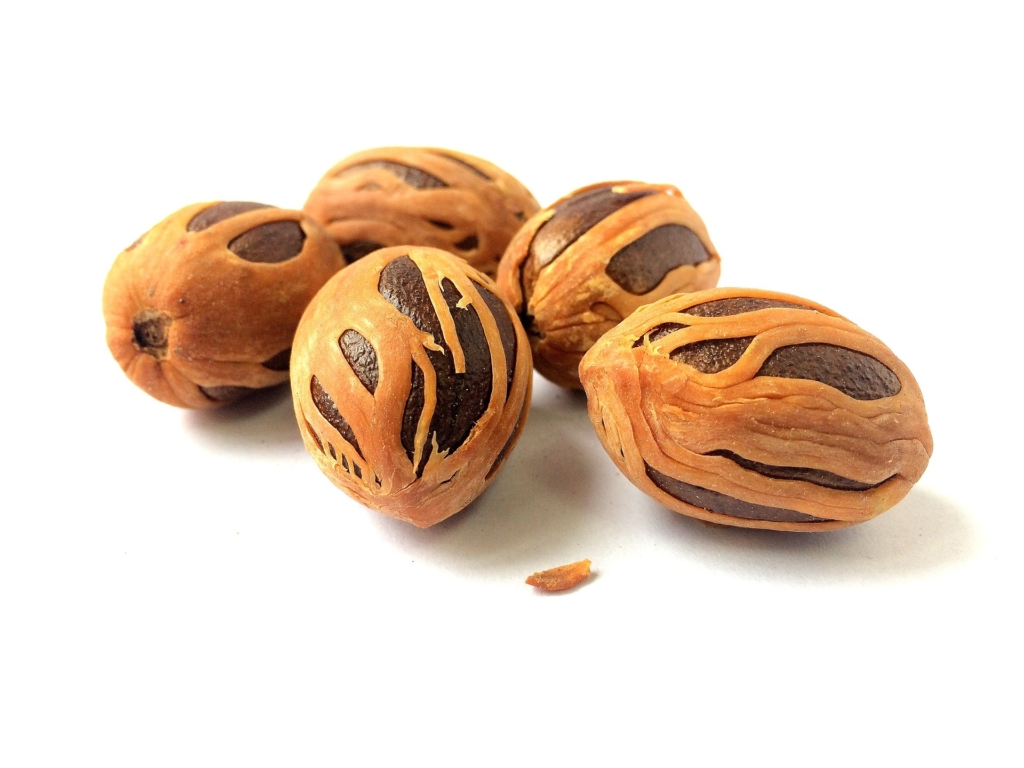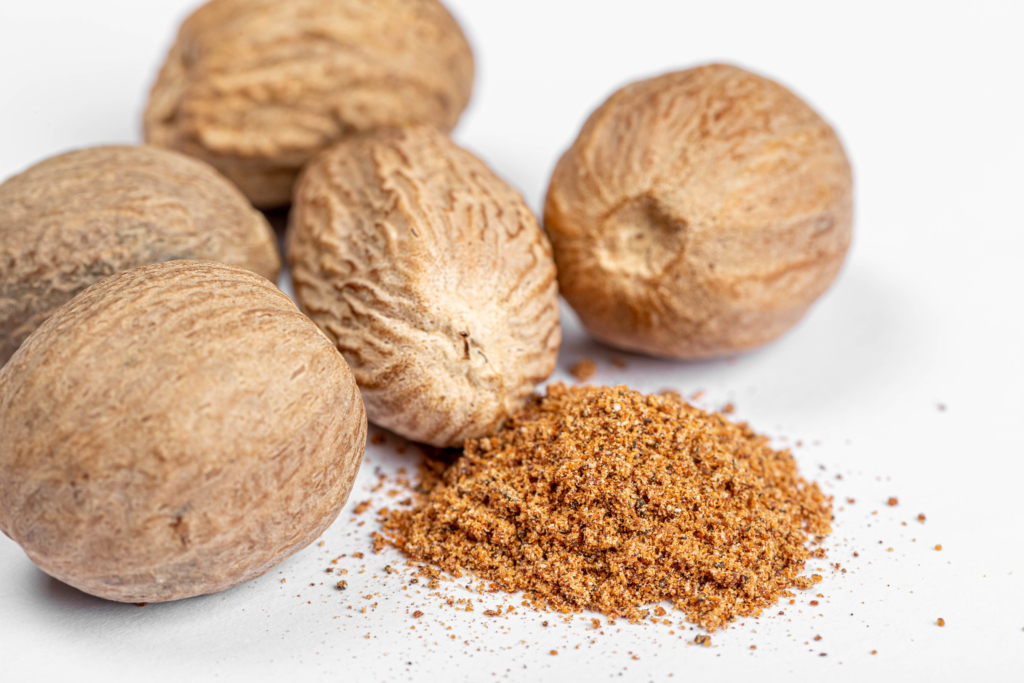Myristica fragrans, or fragrant nutmeg, is a tropical evergreen tree known primarily for the seeds that it produces. The seeds, which are encased in a light-yellow, edible fruit, produce two spices: nutmeg and mace. Well-known nutmeg comes from the interior seed, while mace is produced from the bright red covering that grows around the nutmeg seed. These inch-long seeds have been used to flavor and perfume dishes across the world for centuries. Italy, in particular, utilizes nutmeg in a variety of sweet and savory applications. But just how did this bountiful tropical plant dig its roots into Italian cuisine? A booming global spice trade with Venice as a main trading port coupled with the medicinal and culinary uses for nutmeg all helped drive its popularity and cement it in Italy’s traditional food culture.
To understand why nutmeg became widespread it is essential to understand its unique flavor as a driver of its popularity. To produce nutmeg the seeds are first dried so that they separate from the outer shell. The shells are then cracked open revealing the small, fragrant brown seed within, which can then be ground or grated for use in recipes. Nutmeg has a warm, delicately sweet and unique taste that can be described as mildly spicy.

Nutmeg is indegenous to the Banda islands in the Philippines and for a long time was grown nowhere else in the world. Flavorful nutmeg was not kept secret for long, however. Byzantine traders in the 6th century began bringing the exotic spice to Europe, where it was soon in high demand. Through the Dark and Middle Ages, Arab traders brought nutmeg to Europe, reaching Venice in the 12th century. Nutmeg was prized for its multifaceted flavor in highly spiced dishes. The limited supply of nutmeg, the long distance it had to travel, and the number of hands it passed through ensured its high price. In the 14th century, a pound of nutmeg cost seven fat oxen and was worth more by weight than gold.
Revered not only for the gustatory qualities that we appreciate today, nutmeg was also highly regarded for its medicinal effects. Physicians in the 17th century prescribed nutmeg as a cure for the Bubonic plague, further driving up its interest and value. Further, large doses of nutmeg were believed to terminate unwanted pregnancies. While nutmeg’s curative powers were largely unfounded, the seed does contain the oil myristicin, which when consumed in large quantities can induce hallucinations. Perhaps the hallucinatory effects of nutmeg were enough to inspire medical confidence in the tiny seed. Regardless of its medical inefficacy, nutmeg remained a highly coveted product.

Like many other spices used in the Middle Ages and Renaissance, nutmeg was cherished not only for its innate qualities, but also for the cultural capital that it held. Spices were expensive and exotic; people who could afford to consume these products elevated themselves above the common person. Spices were used as a form of social posturing. Records and recipes from the 16th century emphasize the use of imported spices in Italian cooking. Venice, in particular, was an extremely wealthy city given its monopoly on trade with India. This concentration of wealth allowed rich Venetians the purchasing power to consume nutmeg. The desire to set oneself apart with extravagant spices drove the market for nutmeg. This insatiable appetite for nutmeg proved profitable for the companies that imported it and ruinous for the indegenous people of the Banda islands.
Because nutmeg was originally only cultivated on the Banda islands and demand for the spice was so high, European colonists were committed to controlling the island and its exports. English, Porteugese, and Dutch traders fought for control of the Banda islands, with the Dutch cementing a monopoly on the island for most of the 17th century. The indigenous Banda people wished to continue trading with other European countries, which was more profitable for them, but the Dutch prohibited free trade with violent suppressive force. The Dutch enslaved and killed the Banda people in their quest to bring nutmeg to international markets. The Dutch occupation and suppression of the Banda people resulted in the deaths of 90% of the population.

Europe’s insatiable appetite for new products led to further expansion and plundering of other regions across the globe. Over time other products reached Europe that further signaled wealth and exoticism, specifically, coffee, tea, and chocolate. These new products diminished the importance of spices in many countries, and spices such as nutmeg took a backseat to these new ingredients.
In Italy, however, nutmeg endures. Many Italian dishes, both sweet and savory, feature nutmeg. Tortellini and cannelloni recipes utilize nutmeg for its earthy sweetness in their rich meat filings. Besciamella, also known as bechamel or white sauce, is flavored with nutmeg and is believed to have been developed in Italy before spreading to France and beyond. Malfatti, an Italian dumpling from Lombardy is made with wild greens, flour, eggs, and a hearty pinch of nutmeg. Italian mulled wine, or vine brule, uses nutmeg among other spices to flavor for the wine. Desserts such as panforte are heavily flavored with spices, including nutmeg.

Nutmeg may no longer garner the price and interest that it once did, but its sweet and fragrant taste still endures in many cuisines. Why does nutmeg persist so widely in Italian cuisine? One theory is that Italian cuisine by nature is very traditional. Families cook the same regional dishes that their mothers and grandmothers made. This commitment to tradition ensures the longevity of dishes that may otherwise have been transformed or altered. Classic dishes from centuries ago, which would have been heavily spiced, retain part of their identity today. This culinary commitment to tradition maintains the link between the past and the present. Each flavorful, nutmeg-studded bite should remind us of the history of the spice trade, the violence it inflicted, the wealth it bestowed, the remedies it purported to provide, and the flavors it introduced to far reaches of the world.
Feature image by scym from Pixabay



